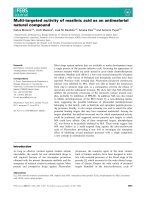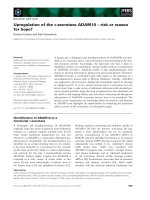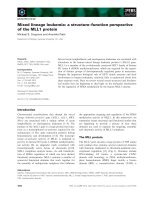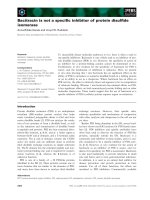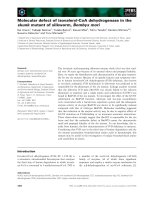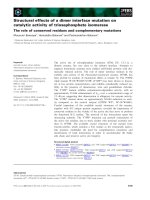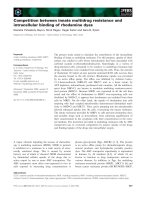Tài liệu Báo cáo khoa học: "Man* vs. Machine: A Case Study in Base Noun Phrase Learning" pdf
Bạn đang xem bản rút gọn của tài liệu. Xem và tải ngay bản đầy đủ của tài liệu tại đây (974.35 KB, 8 trang )
Man* vs. Machine: A Case Study in Base Noun Phrase Learning
Eric Brill and Grace Ngai
Department of Computer Science
The Johns Hopkins University
Baltimore, MD 21218, USA
Email: (brill,gyn}~cs. jhu.
edu
Abstract
A great deal of work has been done demonstrat-
ing the ability of machine learning algorithms to
automatically extract linguistic knowledge from
annotated corpora. Very little work has gone
into quantifying the difference in ability at this
task between a person and a machine. This pa-
per is a first step in that direction.
1 Introduction
Machine learning has been very successful at
solving many problems in the field of natural
language processing. It has been amply demon-
strated that a wide assortment of machine learn-
ing algorithms are quite effective at extracting
linguistic information from manually annotated
corpora.
Among the machine learning algorithms stud-
ied, rule based systems have proven effective
on many natural language processing tasks,
including part-of-speech tagging (Brill, 1995;
Ramshaw and Marcus, 1994), spelling correc-
tion (Mangu and Brill, 1997), word-sense dis-
ambiguation (Gale et al., 1992), message un-
derstanding (Day et al., 1997), discourse tag-
ging (Samuel et al., 1998), accent restoration
(Yarowsky, 1994), prepositional-phrase attach-
ment (Brill and Resnik, 1994) and base noun
phrase identification (Ramshaw and Marcus, In
Press; Cardie and Pierce, 1998; Veenstra, 1998;
Argamon et al., 1998). Many of these rule based
systems learn a short list of simple rules (typ-
ically on the order of 50-300) which are easily
understood by humans.
Since these rule-based systems achieve good
performance while learning a small list of sim-
ple rules, it raises the question of whether
peo-
*and Woman.
65
ple could also derive an effective rule list man-
ually from an annotated corpus. In this pa-
per we explore how quickly and effectively rel-
atively untrained people can extract linguistic
generalities from a corpus as compared to a ma-
chine. There are a number of reasons for doing
this. We would like to understand the relative
strengths and weaknesses of humans versus ma-
chines in hopes of marrying their con~plemen-
tary strengths to create even more accurate sys-
tems. Also, since people can use their meta-
knowledge to generalize from a small number of
examples, it is possible that a person could de-
rive effective linguistic knowledge from a much
smaller training corpus than that needed by a
machine. A person could also potentially learn
more powerful representations than a machine,
thereby achieving higher accuracy.
In this paper we describe experiments we per-
formed to ascertain how well humans, given
an annotated training set, can generate rules
for base noun phrase chunking. Much previous
work has been done on this problem and many
different methods have been used: Church's
PARTS (1988) program uses a Markov model;
Bourigault (1992) uses heuristics along with a
grammar; Voutilainen's NPTool (1993) uses a
lexicon combined with a constraint grammar;
Juteson and Katz (1995) use repeated phrases;
Veenstra (1998), Argamon, Dagan & Kry-
molowski(1998) and Daelemaus, van den Bosch
& Zavrel (1999) use memory-based systems;
Ramshaw & Marcus (In Press) and Cardie &
Pierce (1998) use rule-based systems.
2
Learning Base Noun Phrases
by
Machine
We used the base noun phrase system of
Ramshaw and Marcus (R&M) as the machine
learning system with which to compare the hu-
man learners.
It
is difficult to compare different
machine learning approaches to base NP anno-
tation, since different definitions of base NP are
used in many of the papers, but the R&M sys-
tem is the best of those that have been tested
on the Penn Treebank. 1
To train their system, R&M used a 200k-word
chunk of the Penn Treebank Parsed Wall Street
Journal (Marcus et al., 1993) tagged using a
transformation-based tagger (Brill, 1995) and
extracted base noun phrases from its parses by
selecting noun phrases that contained no nested
noun phrases and further processing the data
with some heuristics (like treating the posses-
sive marker as the first word of a new base
noun phrase) to flatten the recursive struc-
ture of the parse. They cast the problem as
a transformation-based tagging problem, where
each word is to be labelled with a chunk struc-
ture tag from the set {I, O, B}, where words
marked 'T' are inside some base NP chunk,
those marked "O" are not part of any base NP,
and those marked "B" denote the first word
of a base NP which immediately succeeds an-
other base NP. The training corpus is first run
through a part-of-speech tagger. Then, as a
baseline annotation, each word is labelled with
the most common chunk structure tag for its
part-of-speech tag.
After the baseline is achieved, transforma-
tion rules fitting a set of rule templates are
then learned to improve the "tagging accuracy"
of the training set. These templates take into
consideration the word, part-of-speech tag and
chunk structure tag of the current word and all
words within a window of 3 to either side of it.
Applying a rule to a word changes the chunk
structure tag of a word and in effect alters the
boundaries of the base NP chunks in the sen-
tence.
An example of a rule learned by the R&M sys-
tem is:
change a chunk structure tag of a word
from I to B if the word is a determiner, the next
word ks a noun, and the two previous words both
have chunk structure tags of I.
In other words,
a determiner in this context is likely to begin a
noun phrase. The R&M system learns a total
1We would like to thank Lance Ramshaw for pro-
viding us with the base-NP-annotated training and test
corpora that were used in the R&M system, as well as
the rules learned by this system.
of 500 rules.
3
Manual Rule
Acquisition
R&M framed the base NP annotation problem
as a word tagging problem. We chose instead
to use regular expressions on words and part of
speech tags to characterize the NPs, as well as
the context surrounding the NPs, because this
is both a more powerful representational lan-
guage and more intuitive to a person. A person
can more easily consider potential phrases as a
sequence of words and tags, rather than looking
at each individual word and deciding whether it
is part of a phrase or not. The rule actions we
allow are: 2
Add Add a base NP (bracket a se-
quence of words as a base NP)
Kill Delete a base NP (remove a pair
of parentheses)
Transform Transform a base NP (move
one or both parentheses to ex-
tend/contract a base NP)
Merge Merge two base NPs
As an example, we consider an actual rule
from our experiments:
Bracket all sequences of words of: one
determiner (DT), zero or more adjec-
tives (JJ, JJR, JJS), and one or more
nouns (NN, NNP, NNS, NNPS), if
they are followed by a verb (VB, VBD,
VBG, VBN, VBP, VBZ).
In our language, the rule is written thus: 3
A
(* .)
({i} t=DT) (* t=JJ[RS]?) (+ t=NNP?S?)
({i} t=VB [DGNPZ] ?)
The first line denotes the action, in this case,
Add a bracketing. The second line defines the
context preceding the sequence we want to have
bracketed in this case, we do not care what
this sequence is. The third line defines the se-
quence which we want bracketed, and the last
2The rule types we have chosen are similar to those
used by Vilain and Day (1996) in transformation-based
parsing, but are more powerful.
SA full description of the rule language can be found
at http://nlp, cs. jhu.
edu/,~baseNP/manual.
6B
line defines the context following the bracketed
sequence.
Internally, the software then translates this
rule into the more unwieldy Perl regular expres-
sion:
s( ( ( ['\s_] +__DT\s+) ( ['\s_] +__JJ [RS] \s+)*
The actual system is located at
http://nlp, cs. jhu. edu/~basenp/chunking.
A screenshot of this system is shown in figure
4. The correct base NPs are enclosed in paren-
theses and those annotated by the human's
rules in brackets.
( ['\s_] +__NNPFS?\s+) +) ( [" \s_] +__VB [DGNPZ] \s+)} 4
{ ( $1 ) $5 ]'g
The base NP annotation system created by
the humans is essentially a transformation-
based system with hand-written rules. The user
manually creates an ordered list of rules. A
rule list can be edited by adding a rule at any
position, deleting a rule, or modifying a rule.
The user begins with an empty rule list. Rules
are derived by studying the training corpus
and NPs that the rules have not yet bracketed,
as well as NPs that the rules have incorrectly
bracketed. Whenever the rule list is edited, the
efficacy of the changes can be checked by run-
ning the new rule list on the training set and
seeing how the modified rule list compares to
the unmodified list. Based on this feedback,
the user decides whether, to accept or reject
the changes that were made. One nice prop-
erty of transformation-based learning is that in
appending a rule to the end of a rule list, the
user need not be concerned about how that rule
may interact with other rules on the list. This
is much easier than writing a CFG, for instance,
where rules interact in a way that may not be
readily apparent to a human rule writer.
To make it easy for people to study the train-
ing set, word sequences are presented in one of
four colors indicating that they:
1. are not part of an NP either in the truth or
in the output of the person's rule set
2. consist of an NP both in the truth and in
the output of the person's rule set (i.e. they
constitute a base NP that the person's rules
correctly annotated)
3. consist of an NP in the truth but not in the
output of the person's rule set (i.e. they
constitute a recall error)
4. consist of an NP in the output of the per-
son's rule set but not in the truth (i.e. they
constitute a precision error)
Experimental Set-Up and Results
The experiment of writing rule lists for base NP
annotation was assigned as a homework set to
a group of 11 undergraduate and graduate stu-
dents in an introductory natural language pro-
cessing course. 4
The corpus that the students were given from
which to derive and validate rules is a 25k word
subset of the R&M training set, approximately
! the size of the full R&M training set. The
8
reason we used a downsized training set was
that we believed humans could generalize better
from less data, and we thought that it might be
possible to meet or surpass R&M's results with
a much smaller training set.
Figure 1 shows the final precision, recall, F-
measure and precision+recall numbers on the
training and test corpora for the students.
There was very little difference in performance
on the training set compared to the test set.
This indicates that people, unlike machines,
seem immune to overtraining. The time the
students spent on the problem ranged from less
than 3 hours to almost 10 hours, with an av-
erage of about 6 hours. While it was certainly
the case that the students with the worst results
spent the least amount of time on the prob-
lem, it was not true that those with the best
results spent the most time
indeed, the av-
erage amount of time spent by the top three
students was a little less than the overall aver-
age slightly over 5 hours. On average, peo-
ple achieved 90% of their final performance after
half of the total time they spent in rule writing.
The number of rules in the final rule lists also
varied, from as few as 16 rules to as many as 61
rules, with an average of 35.6 rules. Again, the
average number for the top three subjects was
a little under the average for everybody: 30.3
rules.
4These 11 students were a subset of the entire class.
Students were given an option of participating in this ex-
periment or doing a much more challenging final project.
Thus, as a population, they tended to be the less moti-
vated students.
67
TRAINING SET (25K Words)
Precision Recall
87.8% 88.6%
88.1% 88.2%
88.6% 87.6%
88.0% 87.2%
86.2% 86.8%
86.0% 87.1%
84.9% 86.7%
83.6% 86.0%
83.9% 85.0%
82.8% 84.5%
84.8% 78.8%
Student 1
Student 2
Student 3
Student 4
Student 5
Student 6
Student 7
Student 8
Student 9
Student 10
Student 11
F-Measure P+n Precision
2
88.2 88.2 88.0%
88.2 88.2 88.2%
88.1 88.2 88.3%
87.6 87.6 86.9%
86.5 86.5 85.8%
86.6 86.6 85.8%
85.8 85.8 85.3%
84.8 84.8 83.1%
84.4 84.5 83.5%
83.6 83.7 83.3%
81.7 81.8 84.0%
TEST SET
Recall F-Measure
88.8% 88.4
87.9% 88.0
87.8% 88.0
85.9% 86.4
85.8% 85.8
87.1% 86.4
87.3% 86.3
85.7% 84.4
84.8% 84.1
84.4% 83.8
77.4% 80.6
2
88.4
88.1
88.1
86.4
85.8
86.5
86.3
84.4
84.2
83.8
80.7
Figure 1: P/R results of test subjects on training and test corpora
In the beginning, we believed that the stu-
dents would be able to match or better the
R&M system's results, which are shown in fig-
ure 2. It can be seen that when the same train-
ing corpus is used, the best students do achieve
performances which are close to the R&M sys-
tem's on average, the top 3 students' per-
formances come within 0.5% precision and 1.1%
recall of the machine's. In the following section,
we will examine the output of both the manual
and automatic systems for differences.
5 Analysis
Before we started the analysis of the test set,
we hypothesized that the manually derived sys-
tems would have more difficulty with potential
rifles that are effective, but fix only a very small
number of mistakes in the training set.
The distribution of noun phrase types, iden-
tified by their part of speech sequence, roughly
obeys Zipf's Law (Zipf, 1935): there is a large
tail of noun phrase types that occur very infre-
quently in the corpus. Assuming there is not a
rule that can generalize across a large number
of these low-frequency noun phrases, the only
way noun phrases in the tail of the distribution
can be learned is by learning low-count rules: in
other words, rules that will only positively af-
fect a small number of instances in the training
corpus.
Van der Dosch and Daelemans (1998) show
that not ignoring the low count instances is of-
ten crucial to performance in machine learning
systems for natural language. Do the human-
written rules suffer from failing to learn these
infrequent phrases?
To explore the hypothesis that a primary dif-
ference between the accuracy of human and ma-
chine is the machine's ability to capture the low
frequency noun phrases, we observed how the
accuracy of noun phrase annotation of both hu-
man and machine derived rules is affected by
the frequency of occurrence of the noun phrases
in the training corpus. We reduced each base
NP in the test set to its POS tag sequence as
assigned by the POS tagger. For each POS tag
sequence, we then counted the number of times
it appeared in the training set and the recall
achieved on the test set.
The plot of the test set recall vs. the number
of appearances in the training set of each tag
sequence for the machine and the mean of the
top 3 students is shown in figure 3. For instance,
for base NPs in the test set with tag sequences
that appeared 5 times in the training corpus,
the students achieved an average recall of 63.6%
while the machine achieved a recall of 83.5%.
For base NPs with tag sequences that appear
less than 6 times in the training set, the machine
outperforms the students by a recall of 62.8%
vs. 54.8%. However, for the rest of the base
NPs those that appear 6 or more times
the performances of the machine and students
are almost identical: 93.7% for the machine vs.
93.5% for the 3 students, a difference that is not
statistically significant.
The recall graph clearly shows that for the
top 3 students, performance is comparable to
the machine's on all but the low frequency con-
stituents. This can be explained by the human's
68
Recall F-Measure
89.3% 89.0
92.3% 92.0
2
89.0
92.1
0.9
Figure 2: P/R results of the R&M system on test corpus
" "" °o."
0.8
0.7~
0.6-
0.5-
0.4-
0.3
o
Training set size(words) Precision
25k 88.7%
200k 91.8%
Number of Appearances in Training Set
• • 4- - • Machine
Students
Figure 3: Test Set Recall vs. Frequency of Appearances in Training Set.
reluctance or inability to write a rule that will
only capture a small number of new base NPs in
the training set. Whereas a machine can easily
learn a few hundred rules, each of which makes
a very small improvement to accuracy, this is a
tedious task for a person, and a task which ap-
parently none of our human subjects was willing
or able to take on.
There is one anomalous point in figure 3. For
base NPs with POS tag sequences that appear
3 times in the training set, there is a large de-
crease in recall for the machine, but a large
increase in recall for the students. When we
looked at the POS tag sequences in question and
their corresponding base NPs, we found that
this was caused by one single POS tag sequence
that of two successive numbers (CD). The
69
test set happened to include many sentences
containing sequences of the type:
( CD CD ) TO ( CD CD )
as in:
( International/NNP Paper/NNP )
fell/VBD ( 1/CD 3/CD ) to/TO (
51/CD ½/CD )
while the training set had none. The machine
ended up bracketing the entire sequence
I/CD -~/CD to/T0 51/CD ½/CD
as a base NP. None of the students, however,
made this mistake.
6 Conclusions and Future Work
In this paper we have described research we un-
dertook in an attempt to ascertain how people
can perform compared to a machine at learning
linguistic information from an annotated cor-
pus, and more importantly to begin to explore
the differences in learning behavior between hu-
man and machine. Although people did not
match the performance of the machine-learned
annotator, it is interesting that these "language
novices", with almost no training, were able to
come fairly close, learning a small number of
powerful rules in a short amount of time on a
small training set. This challenges the claim
that machine learning offers portability advan-
tages over manual rule writing, seeing that rel-
atively unmotivated people can near-match the
best machine performance on this task in so lit-
tle time at a labor cost of approximately US$40.
We plan to take this work in a number of di-
rections. First, we will further explore whether
people can meet or beat the machine's accuracy
at this task. We have identified one major weak-
ness of human rule writers: capturing informa-
tion about low frequency events. It is possible
that by providing the person with sufficiently
powerful corpus analysis tools to aide in rule
writing, we could overcome this problem.
We ran all of our human experiments on a
fixed training corpus size. It would be interest-
ing to compare how human performance varies
as a function of training corpus size with how
machine performance varies.
There are many ways to combine human
corpus-based knowledge extraction with ma-
chine learning. One possibility would be to com-
bine the human and machine outputs. Another
would be to have the human start with the out-
put of the machine and then learn rules to cor-
rect the machine's mistakes. We could also have
a hybrid system where the person writes rules
with the help of machine learning. For instance,
the machine could propose a set of rules and
the person could choose the best one. We hope
that by further studying both human and ma-
chine knowledge acquisition from corpora, we
can devise learning strategies that successfully
combine the two approaches, and by doing so,
further improve our ability to extract useful lin-
guistic information from online resources.
70
Acknowledgements
The authors would like to thank Ryan Brown,
Mike Harmon, John Henderson and David
Yarowsky for their valuable feedback regarding
this work. This work was partly funded by NSF
grant IRI-9502312.
References
S. Argamon, I. Dagan, and Y. Krymolowski.
1998. A memory-based approach to learning
shallow language patterns. In
Proceedings of
the ITth International Conference on Compu-
tational Linguistics,
pages 67-73. COLING-
ACL.
D. Bourigault. 1992. Surface grammatical anal-
ysis for the extraction of terminological noun
phrases. In
Proceedings of the 30th Annual
Meeting of the Association of Computational
Linguistics,
pages 977-981. Association of
Computational Linguistics.
E. Brill and P. Resnik. 1994. A rule-based
approach to prepositional phrase attachment
disambiguation. In
Proceedings of the fif-
teenth International Conference on Compu-
tational Linguistics (COLING-1994).
E. Brill. 1995. Transformation-based error-
driven learning and natural language process-
ing: A case study in part of speech tagging.
Computational Linguistics,
December.
C. Cardie and D. Pierce. 1998. Error-driven
pruning of treebank gramars for base noun
phrase identification. In
Proceedings of the
36th Annual Meeting of the Association of
Computational Linguistics,
pages 218-224.
Association of Computational Linguistics.
K. Church. 1988. A stochastic parts program
and noun phrase parser for unrestricted text.
In
Proceedings of the Second Conference on
Applied Natural Language Processing,
pages
136-143. Association of Computational Lin-
guistics.
W. Daelemans, A. van den Bosch, and J. Zavrel.
1999. Forgetting exceptions is harmful in lan-
guage learning. In
Machine Learning, spe-
cial issue on natural language learning,
vol-
ume 11, pages 11-43. to appear.
D. Day, J. Aberdeen, L. Hirschman,
R. Kozierok, P. Robinson, and M. Vi-
lain. 1997. Mixed-initiative development
of language processing systems. In
Fifth
Conference on Applied Natural Language
~nUre corpus ~mSed lines only ~l'recision a'ro. only ~ errors only
~3rep on re~c
Rules so far:
(Reload frame
ON
EVERY ITERATION
to make=urethat
contents rare up to date)
1~e in yore mla in thebox bdow,
Tlmn~ for your im~dpation and good luck~
existential/pronoun Pule
(e ,)
({1 } t=(EX I PRP IWP It~T))
(* .)
#
dete rm~ ne r+adjecti re+noun
A,
(-({1})t=(DT))
(*
t=(CDt33[RS]?IVBG)) (+ t=NNS?)
(* .)
#
POS+adjecti ves+nouns
A
(* .)
({1} t=PO5) (? t=(JJ[RS]?IVBNIVBG)) (+ t=NNS?)
(* .)
([-~T-t~ird-lar~st ,3
thriftNN
i~titutionNN D
hi m ([PtlcrtONN P
RiCONNp]) ahoRB
==Jdv~
([itpap])
exlmCtSv~
([aljT retnrnNs])
tOTo ([profitabilitysN ] ) in m ([theft third;~ quartersN])Wltc~wl ~
([itpRl~]) rePOr~vBZ (opc~tingvB G rcsultsvl ~ ([thiZDT weekNN])
Sem~ce
499:
([POneeNN P Federalt, iNp] ) Illddv~ ([th%T divid~dNN])WltSv~
IRl=FatdedvBN inlN ([.anticipationN NI) OliN (m0reRBR [|tzhlgl~tjj
~Pimlss
r~u~u~nsss]
)und=m
[
(~r
Financi~ssP
institotiomNN p
Pd~OIIlINNP] ,, [I~d~C~NNP] ,,'ndcc
[FmforeememtNN P AetNN P] ) ofm ([1989cD]) .;
$mtcnc¢ .~0:
([%~
labor ~,~=tn
~o~PNN])~'~ ~-~o ([~
rcvisedvB N buy-otltNn bidNN] ) for m [ (Onited~Np Aklin=NsPS
~-,-t,N]
[UALNNp CO~' N.p] )
([t~tw~r]),,,~d~ m,~
([=~Jo~N.
~'~l'~ N])=~o ([~mp~s]) ~
Figure 4: Screenshot of base NP chunking system
Processing,
pages 348-355. Association for
Computational Linguistics, March.
W. Gale, K. Church, and D. Yarowsky. 1992.
One sense per discourse. In
Proceedings of
the 4th DARPA Speech and Natural Language
Workship,
pages 233-237.
J. Juteson and S. Katz. 1995. Technical ter-
minology: Some linguistic properties and an
algorithm for identification in text.
Natural
Language Engineering,
1:9-27.
L. Mangu and E. Brill. 1997. Automatic rule
acquisition for spelling correction. In
Pro-
ceedings of the Fourteenth International Con-
ference on Machine Learning,
Nashville, Ten-
nessee.
M. Marcus, M. Marcinkiewicz, and B. Santorini.
1993. Building a large annotated corpus of
English: The Penn Treebank.
Computational
Linguistics,
19(2):313-330.
L. Ramshaw and M. Marcus. 1994. Exploring
the statistical derivation of transformational
71
rule sequences for part-of-speech tagging. In
The Balancing Act: Proceedings of the A CL
Workshop on Combining Symbolic and Sta-
tistical Approaches to Language,
New Mexico
State University, July.
L. Ramshaw and M. Marcus. In Press. Text
chunking using transformation-based learn-
ing. In
Natural Language Processing Using
Very large Corpora.
Kluwer.
K. Samuel, S. Carberry, and K. Vijay-
Shanker. 1998. Dialogue act tagging with
transformation-based learning. In
Proceed-
ings of the 36th Annual Meeting of the As-
sociation for Computational Linguistics,
vol-
ume 2. Association of Computational Linguis-
tics.
A. van der Dosch and W. Daelemans. 1998.
Do not forget: Full memory in memory-
based learning of word pronunciation. In
New
Methods in Language Processing,
pages 195-
204. Computational Natural Language Learn-
ing.
J. Veenstra. 1998. Fast NP chunking
using memory-based learning techniques.
In
BENELEARN-98: Proceedings of the
Eighth Belgian-Dutch Conference on Ma-
chine Learning,
Wageningen, the Nether-
lands.
M. Vilain and D. Day. 1996. Finite-state
parsing by rule sequences. In
International
Conference on Computational Linguistics,
Copenhagen, Denmark, August. The Interna-
tional Committee on Computational Linguis-
tics.
A Voutilainen. 1993.
NPTool,
a detector of
English noun phrases. In
Proceedings of the
Workshop on Very Large Corpora,
pages 48-
57. Association for Computational Linguis-
tics.
D. Yarowsky. 1994. Decision lists for lexi-
cal ambiguity resolution: Application to ac-
cent restoration in Spanish and French. In
Proceedings of the 32nd Annual Meeting of
the Association for Computational Linguis-
tics,
pages 88-95, Las Cruces, NM.
G. Zipf. 1935.
The Psycho-Biology of Language.
Houghton Mifflin.
72
